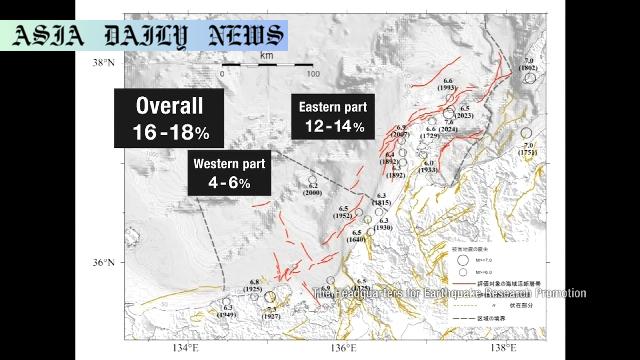Earthquake: The Japanese government’s panel highlights a significant 16-18% chance of an M7+ quake hitting off the Kinki and Hokuriku regions within the next three decades.
Key Point 1: Japanese government panel estimates a 16-18% chance of an M7+ earthquake hitting off Kinki to Hokuriku regions in 30 years.
Key Point 2: Western waters in the Sea of Japan have a 4-6% risk, and eastern waters face a higher risk of 12-14%.
Key Point 3: Recent earthquake on New Year’s Day 2024 reduced chances of imminent seismic activity in the Noto Peninsula fault zone.
Key Point 4: The government urges preparation, emphasizing tsunami risks and potential tremors for the Japanese Sea region.

Assessing the Earthquake Risk in the Sea of Japan
The Japanese government’s earthquake research committee has released sobering statistics about the likelihood of a major earthquake occurring in the Sea of Japan. According to their findings, there is a 16-18% chance of a magnitude 7 or higher earthquake striking the waters between the Kinki and Hokuriku regions within the next 30 years. While such projections may seem modest in absolute terms, they represent a real and pressing concern for individuals and communities along Japan’s western coastline.
The report divides the estimated risks by region. Western sections of the Sea of Japan are estimated to face a comparatively reduced risk of 4-6%, while the eastern regions face a significantly higher likelihood of 12-14%. This variance reflects the geography, geology, and seismic activity of those areas. Notably, these areas include fault zones that have caused major earthquakes in the past, further increasing concerns about future activity.
Noto Peninsula and Recent Seismic Events
The committee further addressed recent seismic activity near the Noto Peninsula. A major earthquake struck the area on New Year’s Day in 2024, intensifying awareness of Japan’s ongoing vulnerability. While the fault zone associated with this event is now considered dormant in the short term, with an “almost zero” chance of immediate activity, the recent event underscores the unpredictable nature of seismic hazards in this region.
University of Tokyo Professor Emeritus Hirata Naoshi, the committee’s head, emphasized the importance of preparedness. “The probability is so high that it would not be surprising if a major earthquake were to occur in our lifetime,” he stated. His warning highlights not only the statistical likelihood of such an event but also the urgency with which preparedness measures must be taken.
Tsunami Threats: A Looming Concern
Beyond ground shaking, the risk of tsunami waves poses a serious secondary threat following a major earthquake. The Sea of Japan’s geographical features mean that tsunami could reach coastal communities quickly, allowing little time for evacuation. Professor Hirata urged communities to take these risks seriously, especially given the unexpected nature of recent earthquakes. Preparing for both shaking and wave-related impacts could save countless lives.
Future Research and Public Awareness
The committee plans to expand its research to cover waters off Niigata Prefecture through Hokkaido, broadening their understanding of risks across the Sea of Japan. This proactive approach reflects Japan’s dedication to addressing seismic risks—a commendable effort in addressing one of the country’s most persistent natural threats. By providing accurate and accessible information, the government hopes to raise public awareness and ensure communities are better equipped to handle disasters.
People living in the at-risk areas are strongly encouraged to keep emergency supplies, familiarize themselves with evacuation routes, and understand region-specific risks. This level of grassroots preparedness will be crucial in minimizing casualties and damage in the event of a major quake.
Conclusion: A Need for Vigilance
The government’s findings reveal the fine balance between technology-enabled foresight and the unpredictability of natural disasters. A 16-18% chance of a major earthquake in the next 30 years may seem like a distant possibility, but it’s a stark reminder of Japan’s ever-present vulnerability to seismic hazards. Preparedness, early warning systems, and public education will remain the cornerstones of mitigating risks in the years ahead.
Commentary
The Importance of Preparedness in Earthquake-Prone Regions
As seismic risks loom over the Sea of Japan, one cannot overstate the importance of preparing for future earthquakes. The statistics provided by the Japanese government panel serve as a wake-up call to the nation. A 16-18% chance of a magnitude 7+ earthquake within 30 years demands a serious and immediate response, not only from authorities but also from local communities and individuals. Living in an earthquake-prone area means embracing a culture of preparedness, and this must be instilled in Japan’s coastal regions. From emergency drills to robust early-warning systems, every effort counts in reducing the human and economic toll of such disasters.
Lessons from Recent Events and History
The recent quake near the Noto Peninsula should remind all of us of the unpredictable nature of these events. Even with sophisticated technology and research, it is impossible to pinpoint exactly when and where the next major quake will strike. However, this recent seismic event also provides a blueprint for how best to respond. Communities must study these examples to better adapt their disaster protocols, focusing on evacuation strategies, resilient infrastructure, and public education programs to minimize the devastation caused by both tremors and tsunamis.
Seismic Preparedness in a Changing World
In a changing climate and an ever-growing global population, the risks associated with natural disasters like earthquakes are compounded. Japan, with its advanced technology and history of resilience, has the tools to lead the way in disaster preparedness. The Sea of Japan’s unique risks—such as the speed at which tsunami waves could reach coastal regions—demand tailored solutions and greater investment in public safety infrastructure. As Professor Hirata stated, the probability of a major quake is high, and it would be complacent to ignore this looming threat. It is my hope that every individual heeds these warnings and takes steps to protect themselves and their families.


